Blog
Discover the four layers of the forest—and the animals living in it
Read moreMarsupials: Animals with pouches
Marsupials are a unique group of mammals characterized by one special trait—pouches. Unlike reptiles and birds, which mostly lay eggs, and other mammals, which give birth to well-developed young, marsupials give birth to premature young. After giving birth, marsupial mothers keep their babies safe inside of pouches attached to their bodies.
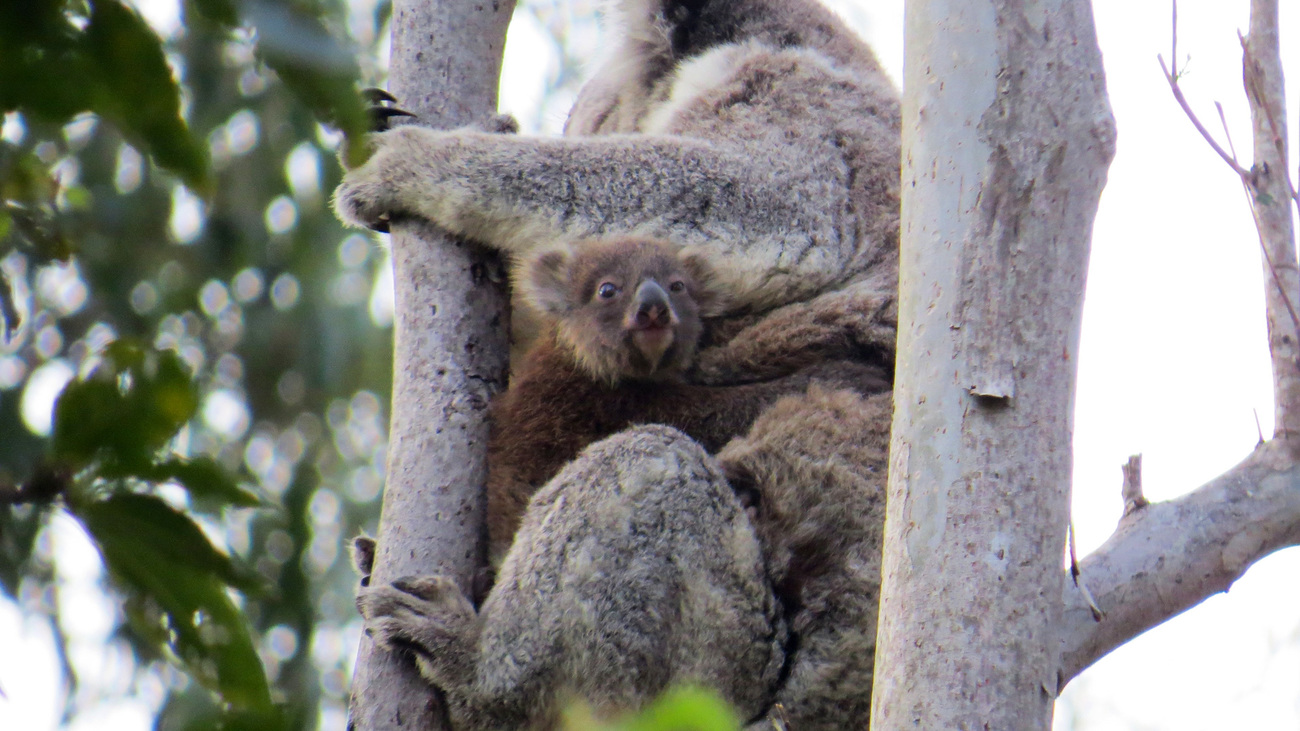
There are three types of mammals, and marsupials are one of those three. The other are monotremes, the few mammals that lay eggs, and placentals, the majority of mammals. Despite not being called placentals, marsupial mothers do have a placenta, which feeds their young while they are inside the uterus. However, their young are born much sooner than those of placental mammals and spend significantly less time feeding from the placenta.
Though found in almost all marsupials, there are a few species that don’t have pouches. One is the shrew opossum, which hides its babies in its fur and skin folds rather than in a proper pouch. Mousesacks, also known as phascogales or wambengers, are also marsupials that lack true pouches. They form ‘pseudo-pouches’ using folds of skin around their mammary glands.
In this blog, we will teach you all you need to know about animals with pouches. Marsupials are a fascinating group of animals to learn about, and many are also in serious danger of extinction due to growing threats like human activities and climate change.
IFAW is a global organization working to combat these threats and others to help marsupials and other animals around the world. To learn more about our work, check out our project pages.
Here are some fast facts about marsupials and some photos of your favourites.
Besides pouches and premature birth, there are a few other defining characteristics of marsupials. For one, their brains are structured quite differently from the brains of other mammals. Marsupials lack a corpus callosum, the part of the brain that connects the two halves in placental mammals. Marsupial brains are also generally smaller than placental mammal brains relative to their body sizes. A quoll and a housecat have a similar skull size, but a quoll has about half as much brain tissue.
Researchers believe that this difference in brain size and structure is why marsupials are generally less intelligent and behave differently than placental mammals. One such difference is marsupials’ limited vocal ability. They typically don’t make noises of excitement or distress, and no young marsupials make cries of hunger to their parents. Koalas are one exception, as they can produce fearsome roars. Kangaroos are known to make grunts, growls, and barks—particularly males, when fighting over females. Mother kangaroos sometimes make soft clucking sounds to communicate with baby kangaroos, known as joeys.
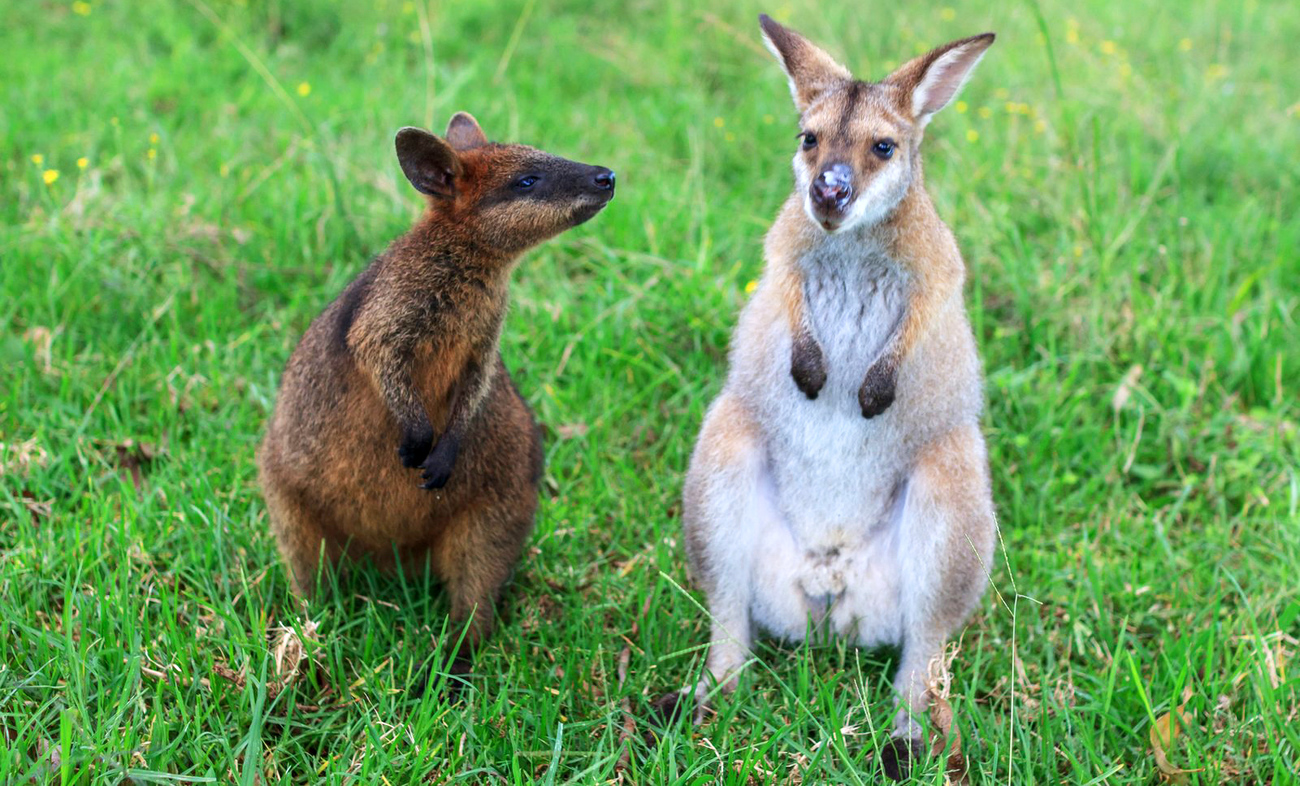
The gestation period of marsupials varies between species, but all of them are relatively short compared to placental mammals.
The shortest gestation period of marsupials is that of the bilby, which lasts only 12 days. The longest is that of the swamp wallaby—38 days.
Kangaroos are only pregnant for about 28 days.
Koalas’ gestation period is on the longer end, about 35 days.
When young marsupials are born, they are in a very premature state compared to placental mammals. While many baby mammals like horses and giraffes are capable of walking on their own within a few hours or minutes, newborn marsupials are virtually helpless. Opossums, for example, are born hairless and blind, weighing less than a dime.
But baby marsupials have a difficult first task. They must climb into their mother’s pouches all on their own. It’s not just a slow but steady climb—it’s more like a race, considering many marsupial moms don’t have enough space in their pouches for all their newborns. Some don’t make it. The fortunate ones attach themselves to their mother’s teats, which firmly fasten to the babies’ mouths. They remain in the pouch for weeks to months, until they are weaned off their mother’s milk.
Today, marsupials are found in parts of Southeast Asia, Oceania, South America, and North America. This includes Australia, New Guinea, Tasmania, the Maluku Islands, Timor, Sulawesi, the Bismarck Archipelago, and the Solomon Islands—as well as in Mexico, Central America, much of South America, and the eastern US.
Though they aren’t native to these areas, marsupials have been introduced by humans to the US Pacific coast and New Zealand.
Australia hosts the most marsupials, as it is home to two-thirds of all marsupial species—over 330 in total. South America is home to about one-third of marsupial species. Perhaps the most well-known marsupials, kangaroos and koalas, are found only in Australia.
Generally, no, male marsupials don’t have pouches. Only females have them, because they are the ones protecting the young. However, in one living marsupial species, males have pouches—the water opossum. These swimmers have evolved pouches to protect their reproductive parts while in the water. Male Tasmanian tigers—an extinct marsupial species—also had pouches.
Yes, marsupials are mammals. They are one of three groups of mammals, besides placentals and monotremes. Marsupials are mammals because they have fur and nurse their young with mammary glands.
There are some commonly confused animals that are mammals, but not marsupials. Platypuses are not marsupials, as they are monotremes—egg-laying mammals. Pandas, bats, raccoons, sloths, and armadillos are NOT marsupials, despite the similarities they may share with some marsupials. They are placental mammals and don’t have pouches.
Below, we explore some famous and lesser-known marsupials. Examples of marsupials include kangaroos, koalas, possums, and opossums.
Marsupials vary greatly in size, shape, and habitat. Here are just a few of the amazing animals with pouches that can be found around the world.
Opossums are medium-sized marsupials found in the Americas. The Virginia opossum is a well-known species in the US, and it’s the only marsupial found there. Known for their ability to play dead—playing ‘possum’, as it’s sometimes called—opossums enter a state called tonic immobility when they feel stressed or threatened. This protects them from predators, who see already dead animals as unappetising. Entering tonic immobility is not voluntary; it happens automatically as a stress response. Opossums’ breathing and heart rate slow, and they remain in this state for up to several hours.
There are over 100 opossum species. On the IUCN Red List, two opossum species are classed as critically endangered, six as vulnerable, and four as near threatened. Major threats to many opossums include agriculture, livestock farming, and logging.

Bandicoots are medium-sized, nocturnal marsupials found in the Australia–New Guinea region. They look similar to mice or shrews, but they are closer in size to rabbits and have long, pointy noses. Bandicoots are good at digging, a skill they use to find worms and grubs, and some species burrow underground.
Female bandicoots can give birth to litters of up to five babies, but typically only one or two survive. Bandicoots stay in their mother’s pouch for about 50 days.
There are over 20 species of bandicoots surviving today, while at least a dozen have gone extinct. Of the surviving species, three are endangered and six are classed as vulnerable by the IUCN. Bandicoot species have experienced extinction and significant population loss following the settlement of their habitats by European colonists, who introduced predators like dogs and cats and cleared the land where bandicoots live.
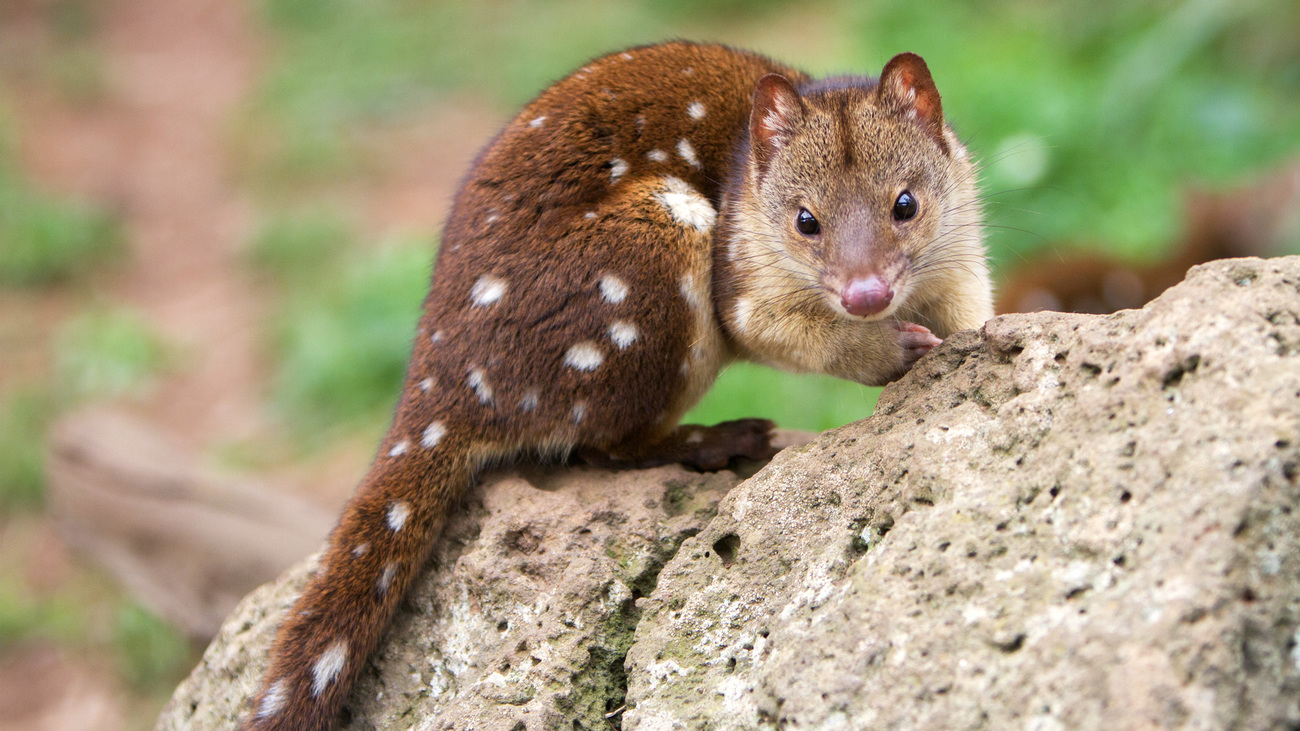
Quolls are carnivorous marsupials found in Australia and New Guinea. There are six quoll species, and they all have brown coats with distinctive white spots. Quolls are mostly nocturnal and spend their days in dens. Quolls vary in size, with some weighing as little as 240 grams (eight ounces) and others weighing as much as seven kilograms (15 pounds).
Female quolls give birth to litters of five to eight pups, which spend the first nine weeks of their lives in their mother’s pouch.
There are six quoll species, two of which are classed as endangered (the northern and eastern quolls) and four of which are classed as near threatened. Land clearing, logging, and bushfires present major threats to quolls’ survival.
Iconic for their grey furry coats and white-tufted ears, koalas are a marsupial species found only in Australia. Their range extends through parts of Queensland, New South Wales, Victoria, and South Australia, though they once could be found in the western half of the continent. Koalas spend a lot of time in trees and mostly eat eucalyptus leaves.
Young koalas, called joeys, spend about six to seven months living in their mothers’ pouches. A strange fact about koalas is that females do not clean their pouches, which is unusual for marsupials. Koala mothers typically have one joey per year.
Koalas are classed as vulnerable by the IUCN. They face habitat loss from human activities, vehicle collisions, attacks from domestic dogs, bushfires, disease, and the drying up of eucalyptus due to climate change—among other threats. IFAW is working in Australia to save these incredible animals and give them a better future.
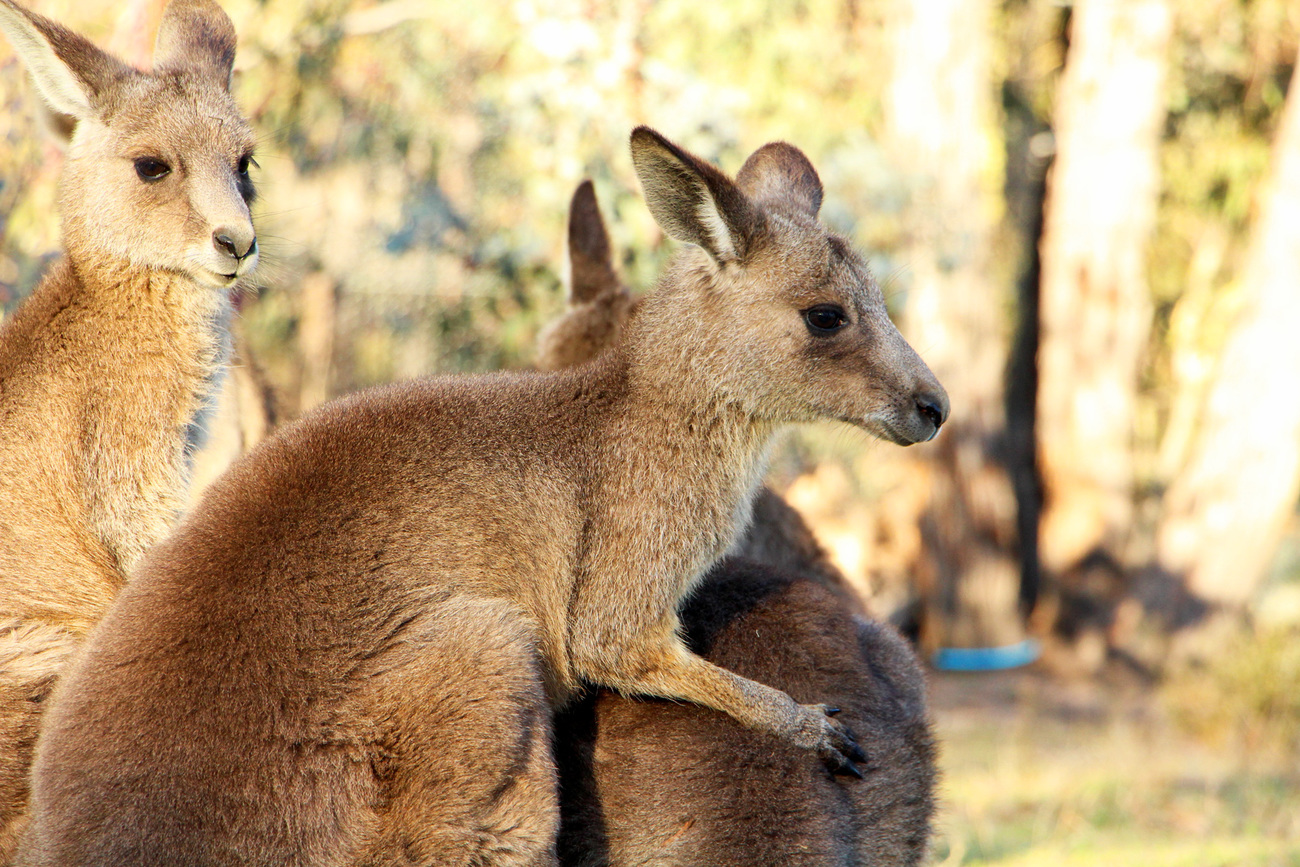
Perhaps the best-known animals with pouches are kangaroos, which are found across Australia. The red kangaroo is the largest marsupial in the world. Other kangaroo species include the eastern grey kangaroo, western grey kangaroo, and antilopine kangroo.
Female red kangaroos give birth to one joey at a time, and they can delay the birth their next baby until the previous one has left the pouch—this ability is known as embryonic diapause. At birth, red kangaroo joeys are only about the size of a jellybean!
Baby red kangaroos stay in their mother’s pouch for about 33 days, after which they will still occasionally enter it when feeling threatened for about eight months. When they’re older, you might see the head and feet of joeys hanging out of their mother’s pouch. After the eight-month period, joeys leave the pouch for good, but they continue to drink milk until they are one year old.
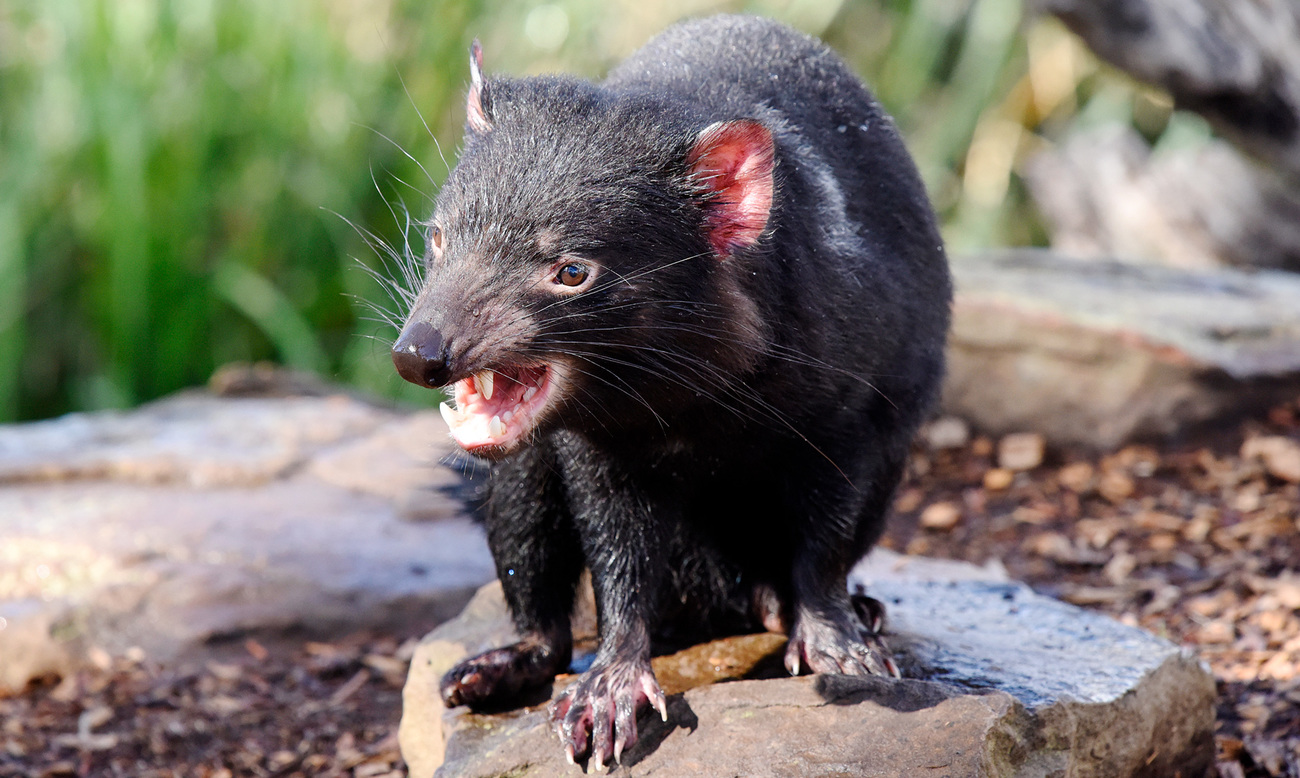
Known for their fierce appearance and strong bite, Tasmanian devils are the largest living carnivorous marsupials—though they aren’t that large at about 30 centimetres (12 inches) tall and four to 14 kilograms (nine to 31 pounds). They are found only on the island of Tasmania and are endangered.
Female Tasmanian devils give birth to litters of 20 to 30 pups at once. However, since they only have four teats, most do not survive. Baby Tasmanian devils stay in their mother’s rear-facing pouch for about four months, after which they stay in a den—often hollowed-out logs—for another month or two, still drinking their mother’s milk.
As an endangered species, Tasmanian devils face serious threats to their survival in the wild. The number one threat to this species is Devil Facial Tumor Disease (DFTD), a fatal, transmissible cancer. They also face road-kills, predation by dogs, the introduction of foxes to Tasmania, persecution by humans, and low genetic diversity.
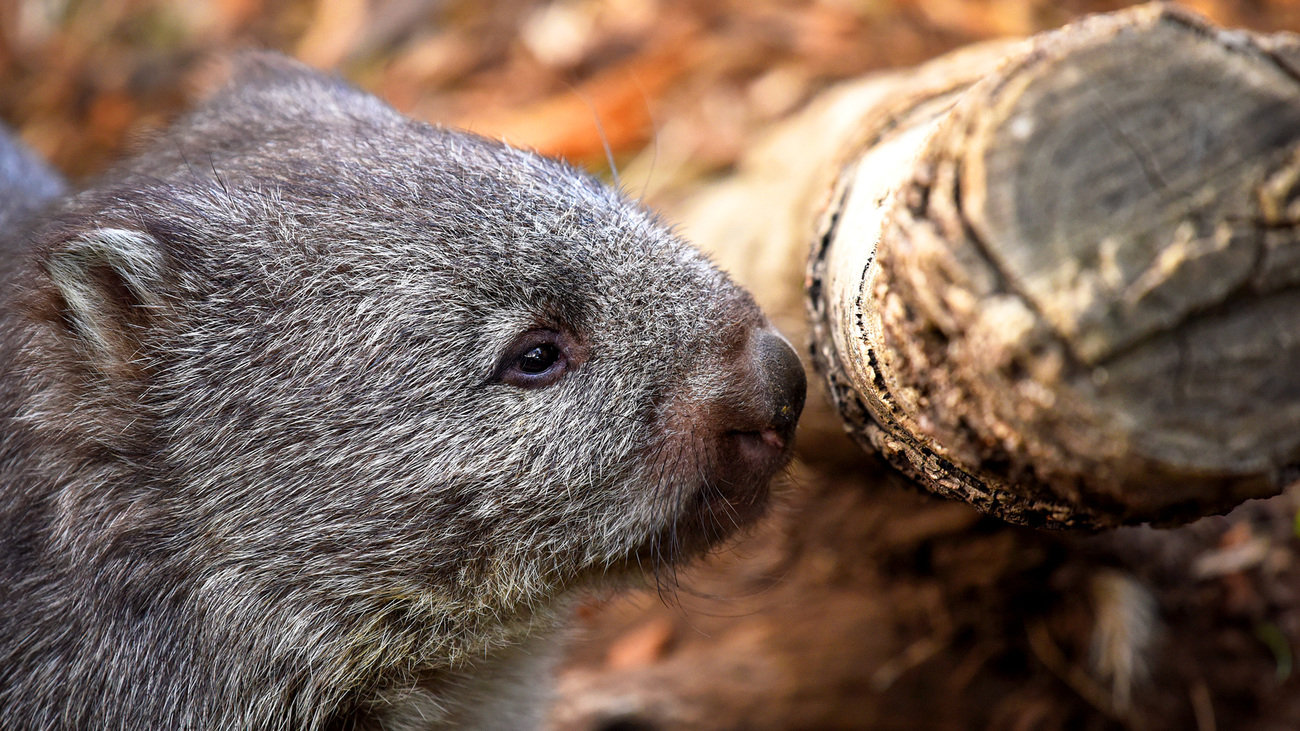
Wombats are short-legged marsupials found in southern and eastern Australia, including Tasmania. There are three wombat species—the common wombat, northern hairy-nosed wombat, and southern hairy-nosed wombat.
A feature all female wombats share is a backwards-facing pouch, which prevents dirt from entering the pouch while they are digging burrows. Wombat mothers give birth to one joey at a time, which weighs only about two grams. When the joey crawls into the pouch, the mother wombat’s teat swells around the baby’s mouth, preventing it from falling out of the pouch. Wombat joeys stay in the pouch for eight to nine months, but they remain with their mothers for another year or more afterwards.
Want to learn more about how IFAW protects koalas, bandicoots, and other animals around the world? Learn more about our work and how you can take action for wildlife.
every problem has a solution, every solution needs support.
The problems we face are urgent, complicated, and resistant to change. Real solutions demand creativity, hard work, and involvement from people like you.
Unfortunately, the browser you use is outdated and does not allow you to display the site correctly. Please install any of the modern browsers, for example:
Google Chrome Firefox Safari